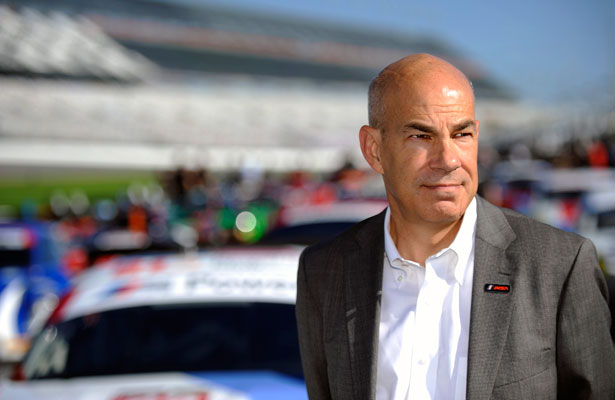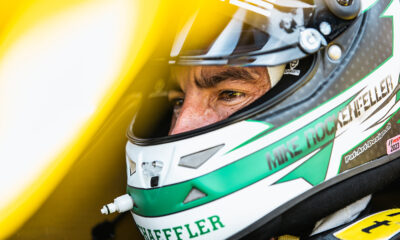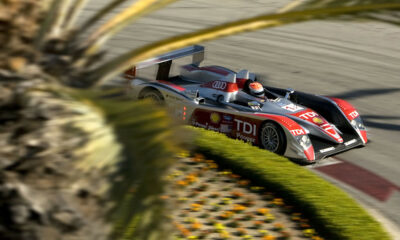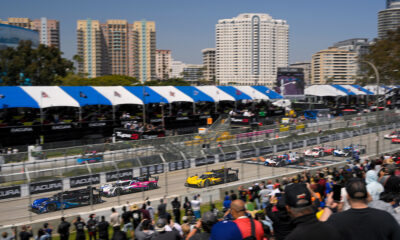
Photo: IMSA
Oftentimes the second year of a new entity is even more important than the first, and the goal for the TUDOR United SportsCar Championship in year two must be to learn from the mistakes and build on the successes the new series had throughout 2014.
It’s with a fine-tooth comb and sincere attention to detail that IMSA President and COO Scott Atherton looks at the 2015 campaign, as part of a series and sanctioning body-wide sweeping overhaul of potential improvements.
“There were so many positives out of both the Rolex 24 and Mobil 1 Twelve Hours of Sebring that didn’t get their just due,” Atherton told Sportscar365.
“This was as a result of the on-track incidents and issues that unfortunately overrided and prevented what I think would have been an otherwise great opening couple of events, that would have set a much different tone for the rest of the season.”
Indeed skepticism lingered in the paddock after the aforementioned 36 hours of Florida, which didn’t go entirely to plan for IMSA.
However, it became obvious throughout the rest of the season that competitor, stakeholder and fan concerns were being heard following the start of the year.
Atherton reflected on the feedback and looked ahead to some of the changes coming for 2015.
“We took a lot of learning from virtually every aspect of our operation in ’14,” he said. “We had customer, stakeholder and fan feedback and to be bluntly honest with you, most of the feedback you get is criticism.
“Human nature is such that when things go well it’s expected; when things don’t, you tend to hear about it.”
“Much of that was constructive, but nonetheless critical. We took all of that as an opportunity to make improvements.”
Atherton then dovetailed into what he termed a “radically changed” rulebook – not in the rules themselves, but in the regulatory language and in terms of refinement and alterations. He estimated nearly, if not more than, 100 changes year-on-year.
Visual changes include the obvious, such as a split start between the Prototype and GT categories, and the fact the qualifying driver will have to start the race in all classes – two elements from the prior GRAND-AM Rolex Series era.
The marketing and operations side of the business has been equally scrutinized.
Atherton noted the departure from MRN and introduction of IMSA Radio, featuring the Radio Show Limited crew led by John Hindhaugh, as a point of re-engagement for fans of the American Le Mans Series persuasion.
“Every aspect of this business has been granularly analyzed and in many respects, altered, from what was the operating system, protocols and procedures of ’14 to what will be those in ‘15,” he said.
“What did we learn? What needs to be changed? There will be elements of both. But everyone will notice some material differences in every aspect, every facet, for ’15 and beyond.”
Still, Atherton took away many successes from the inaugural season of 2014. He hailed the competition and technical departments, who achieved a near-impossible task of balancing two entirely disparate types of prototypes and led to generally speaking, closer lap times and close racing at most circuits.
The overall DP/P2 win balance was tilted nine to two in favor of DPs, but eight different manufacturers and all three tire manufacturers winning at least once between all four classes spoke to the diversity throughout the field – as did 54 total drivers scoring at least one podium finish.
He also hailed the spectator experience, television production and staff integration as other positives. He did say the television aspect came under scrutiny in the first half of 2014, noting the number of deliverables that had to be achieved.
“We simply had too much commercial content and too many deliverables that had to be fulfilled in each broadcast,” he said. “But the product on television, the production value, especially as the season went on, is something by the end of the year we were very proud of.”
Looking ahead to 2015, and further into 2016 and beyond as new cars enter the series, there are several outstanding things to consider.
The process of determining where FIA GT3-spec cars, which are set for introduction into GT Daytona, fit in pace-wise is underway.
Atherton also said it was “too early to say” where LMP3 might fit in, and will also gauge where Prototype Challenge winds up at the end of its planned lifespan through 2016.
Goals for 2015 include the obvious, in terms of growing respective audiences at track, on television, and on IMSA’s websites. Atherton also said IMSA seeks to “increase the value proposition” for all stakeholders.
Atherton later revealed one of the more important points in terms of what IMSA seeks to improve in 2015.
“We have a goal to achieve a happy paddock,” Atherton said. “It’s one of those things that’s hard to define, but you know it when you see it, when you experience it.
“All of us were challenged through this difficult first year in this new era of IMSA. There were many times when our paddock, frankly, wasn’t happy with actions, decisions or practices we had to deploy.
“We recognized where corrective action needed to be taken. There will be tangible evidence of our efforts to make material changes and improvements in many facets that will ultimately result in a much happier paddock.
“A happier paddock is better for everybody. That will make this a more attractive destination of choice for those with the discretionary decision of where they choose to race.”






















